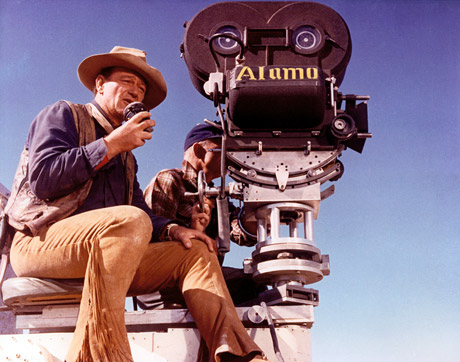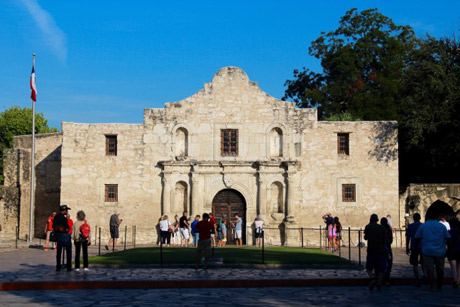John Wayne has been gone for over 30 years yet every year he is still ranked one of two, by the Harris poll , as America’s favorite movie star. He made over 200 films in his 50 year career. None touched him more than the story of the Alamo.
The heroic story of 185 men pledging to fight to the last man for the cause of liberty. The line in the sand in the defense of the Alamo will live forever, in part, because of John Wayne who memorialized it in a great film for future generations. Wayne said, “This adobe chapel is a monument to a defeat. This is where Davy Crockett, William Travis, Jim Bowie and 181 other fighting men lost the battle, which won the war for Texas Independence.”
This was one story that Wayne had to make into a movie. He invested all his money including mortgaging his home and production company into the making. Wayne even donated his own salary as star, director and producer for the cause of the film. Can you imagine anyone in Hollywood doing that today?
Wayne spent 14 years on the making of the Alamo. He visited San Antonio and the actual Alamo sites numerous times. His original plan was to film the Alamo movie at the actual battle site. Unfortunately, modern San Antonio with its skyscrapers and skyline made that virtually impossible for a movie set in the 1830s. John Wayne eventually settled on a film location in Brackettville, Texas which is 120 miles southwest of San Antonio.
Brackettville’s Alamo Village
Wayne with the help of Happy Shahan built Brackettville’s Alamo Village, which was an exact reproduction of the Alamo shrine and the city of old San Antonio. Principle filming began in August 1959. Back in San Antonio, Wayne’s “Batjac” production maintained a hospitality suite at the “Mengar Hotel.” Over the years, the Mengar Hotel was Wayne’s go to location to stay while doing Alamo research. The hotel is located right next to the Alamo.
Mengar Hotel History
The Mengar Hotel was established in 1859. It is the oldest hotel west of the Mississippi river. Eleven US Presidents have stayed at the Mengar along with Babe Ruth, Generals Robert E. Lee and George S. Patton. President Teddy Roosevelt recruited his “rough riders” soldiers from the hotel bar in 1898. Ronald Reagan and Richard Nixon each dined in the “Colonial Room” restaurant. The Colonial room was also used by John Wayne for several Alamo premiere parties and his 1960 press conference.
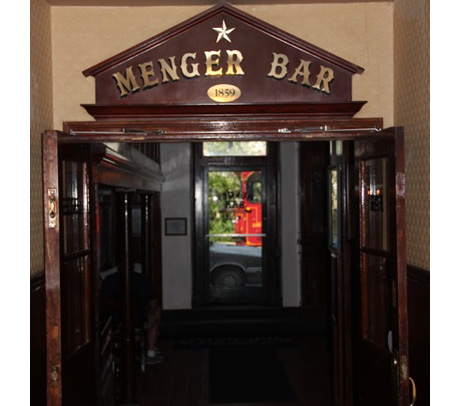
Menger Bar
Staying at the hotel is a trip down memory lane. The rooms were small compared to the modern hotels. The elegance of the hotel lobby was incredible. Three oval levels boast paintings from the 1800s. It felt like Teddy Roosevelt could ride up on his horse at any moment.
The Teddy Roosevelt’s bar was a step back in time. Not too many solid wooden dark bars left in America. All the bartenders were friendly and knowledgeable about hotel and San Antonio history.
Visiting the Alamo
The Alamo is run by the State of Texas as a national monument. There is no entry fee and the shrine is open to the public on most days. It’s best to book a tour with an Alamo guide so you can be taken step by step into the battle. Simply walking through the Alamo looking at the different artifacts is simply not enough.

Marker of Crockett’s death.
Our Alamo guide was Wade Dillon who took us to Davy Crockett’s last stand and to exhibits with Jim Bowie’s knife and other features of the battlefield. Inside the gift shop, there was a glass case featuring the coonskin cap that John Wayne wore in the 1960 Alamo movie. Wayne had donated it to the Daughters of the Texas Revolution after film and was kept in storage. Recently, the cap was re-discovered and now placed on display for the public.

Coonskin cap that John Wayne wore in the 1960 Alamo movie
No visit to San Antonio would be complete without visits to the San Fernando Church and the Riverwalk. The San Fernando Church houses the remains of the Alamo defenders.
After the fall of the Alamo, General Santa Anna ordered the burning of the deceased. Texas founding father Juan Seguin buried the remains in front of the church.
The San Antonio River runs through the city. On either side of the river, numerous restaurants and hotels have been built. Forty-minute boat tours of the Riverwalk are available. During the week-long celebration for the premiere of the Alamo, Wayne and cast were featured in a boat parade down the Riverwalk.
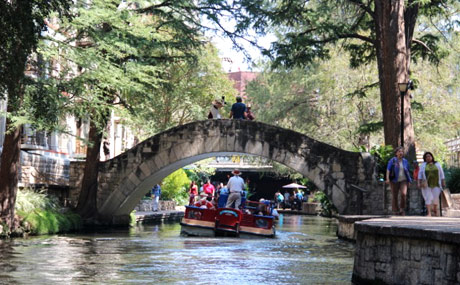
San Antonia River Walk
Brackettville
For over a hundred years, Brackettville survived based mostly on the Fort Clark Calvary army base. The fort had stationed over 10,000 active duty soldiers who helped the community of Brackettville exist financially. By the end of World War II, a decision was made to close the base. By the early 1950s. Brackettville was on the verge of bankruptcy.
The town Mayor James” Happy” Shahan decided to make a hail Mary pass to Hollywood. He had this idea to save his city with the help of Hollywood making movies in Brackettville. With a little help from Walt Disney’s personal secretary, Happy Shahan got his foot in the door with Paramount Pictures who were looking for a location to film their next western. Three westerns were filmed in the 1950s in the area of Brackettville.
In 1957, Shahan hit the Hollywood jackpot when John Wayne decided to film his epic The Alamo in Brackettville. The set would include an exact reproduction of the Alamo and the town of old San Antonio. The Wayne production put the people of Brackettville and all of South Texas to work. Wayne hired thousands of set builders, caters, and extras for the film.
Fort Clark Springs

Fort Clark Entrance
John Wayne and his company stayed in the old Fort Clark complex. He and his family personally stayed for almost four months at the Wainwright House, which was the former Commanding Officer’s residence. The cast and crew used the former army barracks for housing during the filming. Batjac Productions (Wayne’s production company) were housed in base officer’s club.
On the morning of November 15, 1959, the cast and crew were awakened by the shouts of “Fire.” The Batjac Administration headquarters was on fire. The actors and crew assisted the local fire department in putting out the fire. During my visit to Fort Clark, the remnants of the burned out buildings’ including the charred rubble is still there. It felt like the fire occurred yesterday not in the fall of 1959.

Picture of Remains from 1959 fire at the Batjac headquarters
We visited the old John Wayne residence at the Wainwright. The house is a fortress. The place was up for sale. After we made contact with the realtor, we quickly received a tour. The house is over 5300 square feet and has a separate guest quarters in a back building. The interior needed some work but the house was in great shape for being built with Texas Limestone in 1875. Asking price for the Wayne house was only $220,000.

Picture of Wainwright House rented by John Wayne
We stayed in the old barracks area which is now converted to a motel. We stayed in the Patton wing like General Patton did. The room was clean and very modest.
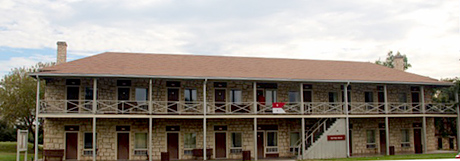
Picture of old army barracks now the Patton motel
Fort Clark boasts about their natural spring swimming pool which is the largest in Texas. The pool was built by the army for the enjoyment of the troops. The cast and crew of the Alamo took advantage of the pool. History showed John Wayne held several BBQs there. Pilar Wayne and co-stars Linda Crystal and Laurence Harvey enjoyed a relaxing swim.
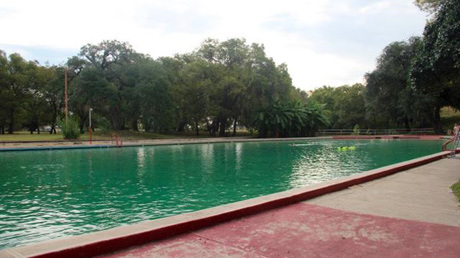
Fort Clark natural springs pool.
Fort Clark is now mostly a retirement community. Most residents are seniors with golf carts. It does have one onsite restaurant named “Las Moras.” It’s one of the only places to eat in the Brackettville area.
Alamo Village
After John Wayne completed his epic 1960’s movie the Alamo, the Alamo Village was turned into a tourist attraction for western movie buffs. It continued to be an active movie set for the next fifty years. Sadly today, western movies no longer seem to be fashion. Alamo Village started to struggle and closed its doors to the public in 2009.

Picture of John Wayne’s Alamo
We were lucky enough to receive a private tour of Alamo Village by Richard Currila. He was the sole historian and curator for the village. Truly the last man standing in the Alamo.
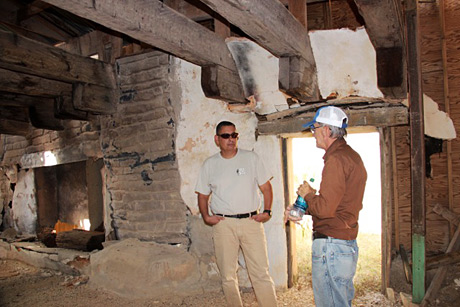
Writer Thomas Marchetti on Alamo tour with tour guide Richard Currila
Touring the old Alamo Village gave me goose bumps. I was walking in the footsteps of heroes. We visited the spot of John Wayne’s Davy Crockett death scene. Wayne, Jimmy Stewart, Dean Martin, and the great John Ford filmed movies in the old village. Fifty years later, father time is taking its toll.
The façade of the Alamo was made with the original adobe brick. It will be here for the next hundred years. Other structures in the movie town are not so fortunate. Repairs are urgently needed to save this part of Texas history.
The Shahan family currently has the Alamo Village along with 5000 acres of land up for sale. Rich Currila hopes a new buyer can be found soon. Money could be invested to save the movie location and bring it back to its former luster. Maybe the State of Texas will step in and declare the area a state park and preserve it for future generations.

Picture of parts of the village fading away
I hope Americans will always remember those 13 days of glory at the siege of the Alamo. John Wayne and Happy Shahan saved Brackettville in the 1950s from becoming extinct. Who will be the hero of today to save the Alamo Village and our history. Anyone seen Donald Trump lately?


